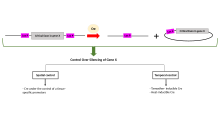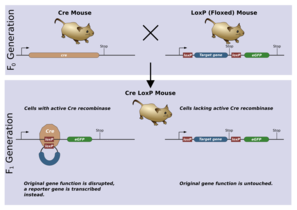Floxing: Difference between revisions
Add deletion |
Add inversion |
||
| Line 22: | Line 22: | ||
[[File:CreLoxP_experiment.png|link=https://en.wikipedia.org/wiki/File:CreLoxP_experiment.png|thumb|297x297px|A model experiment in genetics using the Cre-lox system: the premature stop sequence present in floxed mice is removed only from cells that express Cre recombinase when the mice are bred together.]] |
[[File:CreLoxP_experiment.png|link=https://en.wikipedia.org/wiki/File:CreLoxP_experiment.png|thumb|297x297px|A model experiment in genetics using the Cre-lox system: the premature stop sequence present in floxed mice is removed only from cells that express Cre recombinase when the mice are bred together.]] |
||
Deletion events are useful for performing gene editing experiments through precisely editing out segments of or even whole genes. Deletion requires floxing of the segment of interest with loxP sites which face the same direction. The Cre recombinase will detect the unidirectional loxP sites and excise the floxed segment of DNA<ref name=":0">{{Cite journal|last=Schwenk|first=F|last2=Baron|first2=U|last3=Rajewsky|first3=K|date=1995-12-25|title=A cre-transgenic mouse strain for the ubiquitous deletion of loxP-flanked gene segments including deletion in germ cells.|url=https://www.ncbi.nlm.nih.gov/pmc/articles/PMC307516/|journal=Nucleic Acids Research|volume=23|issue=24|pages=5080–5081|issn=0305-1048|pmid=8559668}}</ref>. The successfully edited clones can be selected using a selection marker which can be removed using the same Cre-loxP system<ref name=":0" />. The same mechanism can be used to create [[Conditional gene knockout|conditional alleles]] by introducing an [[FLP-FRT recombination|FRT/Flp]] site which accomplishes the same mechanism but with a different enzyme. |
Deletion events are useful for performing gene editing experiments through precisely editing out segments of or even whole genes. Deletion requires floxing of the segment of interest with loxP sites which face the same direction. The Cre recombinase will detect the unidirectional loxP sites and excise the floxed segment of DNA<ref name=":0">{{Cite journal|last=Schwenk|first=F|last2=Baron|first2=U|last3=Rajewsky|first3=K|date=1995-12-25|title=A cre-transgenic mouse strain for the ubiquitous deletion of loxP-flanked gene segments including deletion in germ cells.|url=https://www.ncbi.nlm.nih.gov/pmc/articles/PMC307516/|journal=Nucleic Acids Research|volume=23|issue=24|pages=5080–5081|issn=0305-1048|pmid=8559668}}</ref>. The successfully edited clones can be selected using a selection marker which can be removed using the same Cre-loxP system<ref name=":0" />. The same mechanism can be used to create [[Conditional gene knockout|conditional alleles]] by introducing an [[FLP-FRT recombination|FRT/Flp]] site which accomplishes the same mechanism but with a different enzyme. |
||
=== Mechanism of Inversion === |
|||
Inversion events are useful for maintaining the amount of genetic material. The inverted genes are not often associated with abnormal [[Phenotype|phenotypes]], meaning the inverted genes are generally viable<ref>{{Cite journal|last=Griffiths|first=Anthony JF|last2=Miller|first2=Jeffrey H.|last3=Suzuki|first3=David T.|last4=Lewontin|first4=Richard C.|last5=Gelbart|first5=William M.|date=2000|title=Inversions|url=https://www.ncbi.nlm.nih.gov/books/NBK22042/|journal=An Introduction to Genetic Analysis. 7th edition|language=en}}</ref>. Cre-loxP recombination that result in insertion requires loxP sites to flox the gene of interest, with the loxP sites oriented towards each other. By undergoing Cre recombination, the region floxed by the loxP sites will become inverted<ref>{{Cite journal|last=Xu|first=Jian|last2=Zhu|first2=Yongling|date=2018-08-31|title=A rapid in vitro method to flip back the double-floxed inverted open reading frame in a plasmid|url=https://www.ncbi.nlm.nih.gov/pmc/articles/PMC6119287/|journal=BMC Biotechnology|volume=18|doi=10.1186/s12896-018-0462-x|issn=1472-6750|pmc=6119287|pmid=30170595}}</ref>, this process is not permanent and can be reversed<ref>{{Cite journal|last=Oberdoerffer|first=Philipp|last2=Otipoby|first2=Kevin L.|last3=Maruyama|first3=Mitsuo|last4=Rajewsky|first4=Klaus|date=2003-11-15|title=Unidirectional Cre-mediated genetic inversion in mice using the mutant loxP pair lox66/lox71|url=https://www.ncbi.nlm.nih.gov/pmc/articles/PMC275577/|journal=Nucleic Acids Research|volume=31|issue=22|pages=e140|doi=10.1093/nar/gng140|issn=0305-1048|pmid=14602933}}</ref>. |
|||
For example, using the [[Cre recombinase]] with the alpha-myosin heavy chain promoter causes the floxed gene to be inactivated in the heart alone. Further, these knockouts can be inducible. In several mouse studies, [[tamoxifen]] is used to induce the Cre recombinase; in this case Cre is fused to a portion of the mouse [[estrogen receptor]] (ER), which is naturally localized to the cytoplasm via its interactions with chaperone proteins such as heat shock protein 70 and 90 ([[Hsp70]] and [[Hsp90]]). Tamoxifen binds to ER and disrupts its interactions with the chaperones. Disruption of chaperone interactions allows the Cre-ER fusion protein to enter the nucleus and perform recombination on the floxed gene.<ref name="HayashiMcMahon2002" /> |
For example, using the [[Cre recombinase]] with the alpha-myosin heavy chain promoter causes the floxed gene to be inactivated in the heart alone. Further, these knockouts can be inducible. In several mouse studies, [[tamoxifen]] is used to induce the Cre recombinase; in this case Cre is fused to a portion of the mouse [[estrogen receptor]] (ER), which is naturally localized to the cytoplasm via its interactions with chaperone proteins such as heat shock protein 70 and 90 ([[Hsp70]] and [[Hsp90]]). Tamoxifen binds to ER and disrupts its interactions with the chaperones. Disruption of chaperone interactions allows the Cre-ER fusion protein to enter the nucleus and perform recombination on the floxed gene.<ref name="HayashiMcMahon2002" /> |
||
Revision as of 21:57, 27 November 2019

In genetics, floxing refers to the sandwiching of a DNA sequence (which is then said to be floxed) between two lox P sites. The terms are constructed upon the phrase "flanking/flanked by LoxP". Recombination between LoxP sites is catalysed by Cre recombinase. Floxing a gene allows it to be deleted (knocked out), translocated or inverted in a process called Cre-Lox recombination. [1] The floxing of genes is essential in the development of scientific model systems as it allows researchers to have spatial and temporal alteration of gene expression.[2] Moreover, animals such as mice can be used as models to study human disease. Therefore, Cre-lox system can be used in mice to manipulate gene expression in order to study human diseases and drug development.[3] For example, using the Cre-lox system, researchers can study Oncogenes and Tumor Supressor genes and their role in development and progression of cancer in mice models.[4]
Uses of floxing in research
Floxing a gene allows it to be deleted (knocked out), translocated or inserted (through various mechanisms in Cre-Lox recombination).
The floxing of genes is essential in the development of scientific model systems as it allows spatial and temporal alteration of gene expression. In layman's terms, the gene can be knocked-out (inactivated) in a specific tissue in vivo, at any time chosen by the scientist. The scientist can then evaluate the effects of the knocked-out gene and identify the gene’s normal function[5]. This is different from having the gene absent starting from conception, whereby inactivation or loss of genes that are essential for the development of the organism may interfere with the normal function of cells and prevent the production of viable offspring[6].
Mechanism of Deletion

Deletion events are useful for performing gene editing experiments through precisely editing out segments of or even whole genes. Deletion requires floxing of the segment of interest with loxP sites which face the same direction. The Cre recombinase will detect the unidirectional loxP sites and excise the floxed segment of DNA[7]. The successfully edited clones can be selected using a selection marker which can be removed using the same Cre-loxP system[7]. The same mechanism can be used to create conditional alleles by introducing an FRT/Flp site which accomplishes the same mechanism but with a different enzyme.
Mechanism of Inversion
Inversion events are useful for maintaining the amount of genetic material. The inverted genes are not often associated with abnormal phenotypes, meaning the inverted genes are generally viable[8]. Cre-loxP recombination that result in insertion requires loxP sites to flox the gene of interest, with the loxP sites oriented towards each other. By undergoing Cre recombination, the region floxed by the loxP sites will become inverted[9], this process is not permanent and can be reversed[10].
For example, using the Cre recombinase with the alpha-myosin heavy chain promoter causes the floxed gene to be inactivated in the heart alone. Further, these knockouts can be inducible. In several mouse studies, tamoxifen is used to induce the Cre recombinase; in this case Cre is fused to a portion of the mouse estrogen receptor (ER), which is naturally localized to the cytoplasm via its interactions with chaperone proteins such as heat shock protein 70 and 90 (Hsp70 and Hsp90). Tamoxifen binds to ER and disrupts its interactions with the chaperones. Disruption of chaperone interactions allows the Cre-ER fusion protein to enter the nucleus and perform recombination on the floxed gene.[2]
References
- ^ Nagy A (2000). "Cre recombinase: the universal reagent for genome tailoring". Genesis. 26 (2): 99–109. doi:10.1002/(SICI)1526-968X(200002)26:2<99::AID-GENE1>3.0.CO;2-B. PMID 10686599.
- ^ a b Hayashi, Shigemi; McMahon, Andrew P. (2002). "Efficient Recombination in Diverse Tissues by a Tamoxifen-Inducible Form of Cre: A Tool for Temporally Regulated Gene Activation/Inactivation in the Mouse". Developmental Biology. 244 (2): 305–318. doi:10.1006/dbio.2002.0597. ISSN 0012-1606. PMID 11944939.
- ^ Mouse genetics : methods and protocols. Singh, Shree Ram,, Coppola, Vincenzo,. New York, NY. ISBN 9781493912155. OCLC 885338722.
{{cite book}}: CS1 maint: extra punctuation (link) CS1 maint: others (link) - ^ "Genetically Engineered Mice for Cancer Research | SpringerLink" (PDF). doi:10.1007/978-0-387-69805-2.pdf.
{{cite journal}}: Cite journal requires|journal=(help) - ^ Hall, Bradford; Limaye, Advait; Kulkarni, Ashok B (2009-9). "Overview: Generation of Gene Knockout Mice". Current protocols in cell biology / editorial board, Juan S. Bonifacino ... [et al.] CHAPTER: Unit–19.1217. doi:10.1002/0471143030.cb1912s44. ISSN 1934-2500. PMC 2782548. PMID 19731224.
{{cite journal}}: Check date values in:|date=(help) - ^ Rodrigues, João V.; Shakhnovich, Eugene I. (2019-08-01). "Adaptation to mutational inactivation of an essential E. coli gene converges to an accessible suboptimal fitness peak". bioRxiv: 552240. doi:10.1101/552240.
- ^ a b Schwenk, F; Baron, U; Rajewsky, K (1995-12-25). "A cre-transgenic mouse strain for the ubiquitous deletion of loxP-flanked gene segments including deletion in germ cells". Nucleic Acids Research. 23 (24): 5080–5081. ISSN 0305-1048. PMID 8559668.
- ^ Griffiths, Anthony JF; Miller, Jeffrey H.; Suzuki, David T.; Lewontin, Richard C.; Gelbart, William M. (2000). "Inversions". An Introduction to Genetic Analysis. 7th edition.
- ^ Xu, Jian; Zhu, Yongling (2018-08-31). "A rapid in vitro method to flip back the double-floxed inverted open reading frame in a plasmid". BMC Biotechnology. 18. doi:10.1186/s12896-018-0462-x. ISSN 1472-6750. PMC 6119287. PMID 30170595.
{{cite journal}}: CS1 maint: unflagged free DOI (link) - ^ Oberdoerffer, Philipp; Otipoby, Kevin L.; Maruyama, Mitsuo; Rajewsky, Klaus (2003-11-15). "Unidirectional Cre-mediated genetic inversion in mice using the mutant loxP pair lox66/lox71". Nucleic Acids Research. 31 (22): e140. doi:10.1093/nar/gng140. ISSN 0305-1048. PMID 14602933.
